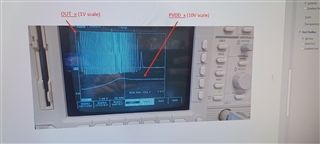Part Number: DRV8432
We have an application where it is possible the motor shaft is spun with no control power to the product.
At this time the motor is a generator and is converted to DC Bus power thru the flyback diodes in the DRV8432 between PVDD_x and GND_x.

We have seen some unit’s fail and cause permanent to the DRV8432 in this case.
Several things to note I have seen in the investigation as to why the component is damaged.
First, how is it possible to have the absolute maximum rating of OUT_x to GND_x of -0.3V in the datasheet?
The lower flyback diode between OUT_x and GND_x forward voltage is stated in the data sheet as 1V. In testing, the forward voltage is near 0.75V, giving a voltage actual of -0.75V (or -1V by data sheet) from OUT_x to GND_x when the motor is acting as a generator, which occurs when braking or reversing a motor as well.
The 12V power rail, VDD, for the DRV8432 in our design is generated off the PVDD_x voltage net, and when the PVDD_x reaches above 17V, the 12V VDD power rail energizes.

The datasheet states there is no required power sequence between VDD and PVDD_x.
In our design the RESET_AB and RESET_CD and connected together and pulled low via a 1K resistor to GND and driven by the CPU. In the case where the motor shaft is spun with no control power, the CPU does not have time to power up and boot before the PVDD_x rail discharges, so the CPU does not drive the RESET_AB, RESET_CD net during this time.
What I see is the RESET_AB and RESET_CD voltage will immediately drop to -0.35V respect to GND and remain there until the VDD power rail is energized. At that time the voltage at RESET_AB and RESET_CD returns to 0.0V. There is 0.0V deviation between GND_x, AGND, and GND of the CPU the entire time. Identifying the cause that the internal logic of the DRV8432 must be driving below ground and seen as a negative voltage on RESET_AB, RESET_CD until the VDD power rail is energized.

What can be done to remedy the situation of damaging the DRV8432?
Is there a safe zone to have the motor spinning, example - a large inertia motor spinning during an Estop situation, that will not damage the DRV8432?

